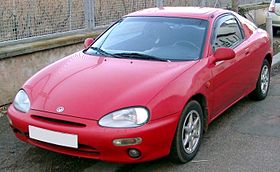Mazda MX-3
| Mazda MX-3 | |
|---|---|
 |
|
| Overview | |
| Manufacturer | Mazda |
| Also called | Mazda MX-3 Precidia Eunos 30X Eunos Presso Autozam AZ-3 Mazda AZ-3 |
| Production | 1991–1998 |
| Assembly | Hofu, Japan |
| Designer | Takeshi Arakawa (1988) |
| Body and chassis | |
| Class | Sport compact |
| Body style | 3-door 2+2 Kammback |
| Layout | FF layout |
| Platform | Mazda EC platform |
| Related | Mazda Familia/323/Protege |
| Powertrain | |
| Engine | 1.5 L B5-ZE I4 DOHC 1.6 L B6-ME I4 SOHC 1.6 L B6D I4 DOHC 1.8 L K8 V6 DOHC |
| Transmission | 5-speed manual 4-speed F4A-EL automatic |
| Dimensions | |
| Wheelbase | 2,455 mm (96.7 in) |
| Length | 4,208 mm (165.7 in) |
| Width | 1,695 mm (66.7 in) |
| Height | 1995-98: 1,321 mm (52.0 in) 1991-95 Base: 1,280 mm (50.4 in) 1991-95 GS: 1,285 mm (50.6 in) |
| Curb weight | RS: 1,095 kg (2,414 lb) GS: 1,171 kg (2,582 lb) |
| Chronology | |
| Predecessor | Mazda Étude |
The Mazda MX-3 is a four-seat compact coupé manufactured and marketed by Mazda, introduced at the Geneva Auto Show in March 1991 and marketed for model years 1992-1998.
The MX-3 was also marketed as the Mazda MX-3 Precidia in Canada, the Eunos 30X in Australia, and as the Eunos Presso, Autozam AZ-3 and Mazda AZ-3 in Japan.
The MX-3's platform is called the EC platform, and shares much with the BG platform of the contemporary Familia/323/Protegé. The first model year available for most markets, including North America where it went on sale in September 1991, was 1992. Originally available with a single-cam 1.6-liter inline-four or the twin-cam V6, a few more engines were available as development continued. In the summer of 1991, the Autozam AZ-3 was added to the Japanese market lineup. It was known by two names;"Autozam" was meant to be Mazda's more youthful brand, so it combined a somewhat lower price with a sportier (but smaller) twin-cam four of 1.5 liters, and also sold as the Eunos Presso, a companion, affordable sports car to the Eunos Roadster.
The small displacement V6 was offered to comply with Japanese government regulations concerning exterior dimensions and engine displacement; Japanese buyers were liable for annual taxes for vehicles exceeding the regulations and large displacement engines, which would affect sales. Japanese buyers who were willing to pay the tax for larger vehicles were now given a choice of the FC series Mazda RX-7 and the JC series Mazda Cosmo.
In January 1994, a DOHC version of the familiar B6 engine, the B6D, replaced the previous version. This provided a useful power increase but conversely also made the considerably more expensive V6 version less desirable. Sales of the V6 in the United States market came to an end after the 1994 model year, although they continued in Canada, Japan and many other export markets. While called K8-DE in North American specs, Japanese and other markets received an engine called the K8-ZE. Aside from emissions equipment and varying power claims due to myriad ratings methods, the differences are negligible.
...
Wikipedia
